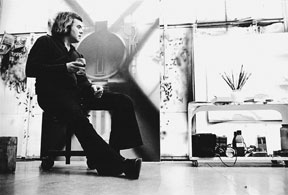
Passages
Passagen- SWITZERLAND, GERMANY / 1972 / German / Color / 16mm / 50 min
Director, Script: Fredi M. Murer
Editing: Yves Yersin, Fredi M. Murer
Sound: Benny Lehman
Appearances: Hans Rudolf Giger, Konrad Farner, Fritz Billeter
Research: Hans-Ulrich Jordi
Producers: Nemo Film, WDR (Cologne)
Source: Athénée Français Cultural Center
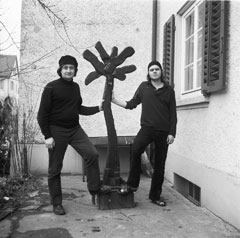
Fredi M. Murer and H.R. Giger
This documentary records the work of Hans Rudolf Giger (1940–2014)—a painter famous as well for his work as a designer for Alien—as he gives birth to the world of a new work. When the film was made, both Giger and Murer were part of a group of young artists that included the poet Urban Gwerder and the composer Jelly Pastorini. Giger was also in charge of costume design for Swiss Made 2069. This film can be thought of as a “passage” that connects Giger’s paintings with the conscious and the unconscious, with memory and with premonitions of the future. It captures both the external influence on the artist of political events happening in society at the time like nuclear tests, satellite launches, the Vietnam War, and the May Uprising, as well as the images that were carved one on top of the other on the artist’s interior during his youth, such as the basement of his house, the dungeons and torture rooms of a castle, and the image of a bleeding Christ. Giger’s magical realism is birthed here through these labyrinthine connections between the internal and the external.
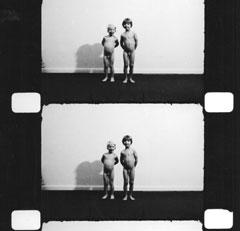 Christopher & Alexander
Christopher & Alexander
- SWITZERLAND / 1973 / French / Color / Digital File (Original: 16mm) / 46 min
Director, Script, Editing: Fredi M. Murer
Photography: Fredi M. Murer, Iwan Schumacher
Sound: Benny Lehman
Music: Jonas C. Haefeli
Producers: Nemo Film, Artco-Film, Eric Franck
Source: Lichtspiel / Kinemathek Bern
This film was commissioned by the financier Eric Franck, and it documents the life of his two sons, a five-year-old named Christopher and a three-year-old named Alexander. Shots of special occurrences during the year (birthdays, Christmas, trips to the zoo or circus) are inserted into footage of the children’s normal life one day. Murer took on the production after being asked to make something that would let the children know after they matured what it had been like to grow up in a bourgeoise household. This film was shot in parallel to We Mountain People in the Mountains, but as Murer himself frequently points out, he depicts both the “highlanders” of Uri as well as the “plateau dwellers” of Zurich. In this sense, both films can be thought of as folkloric.
We Mountain People in the Mountains
Wir Bergler in den Bergen sind eigentlich nicht schuld, dass wir da sind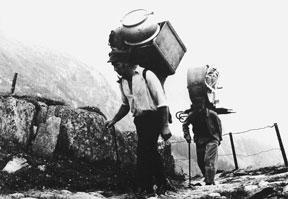
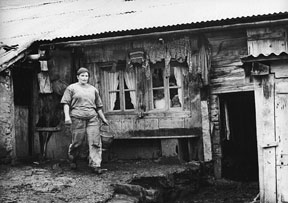
- SWITZERLAND / 1974 / Swiss-German / Color / 16mm / 108 min
Director: Fredi M. Murer
Script: Fredi M. Murer, Jean-Pierre Hoby, Georg Kohler
Photography: Iwan Schumacher
Editing: Fredi M. Murer, Eveline Brombacher
Sound: Luc Yersin
Scripter, Lighting: Benny Lehman
Production Company: Nemo Film
Supported by: Swiss Broadcasting, The Swiss Federal Department of Home Affairs, Migros, The Canton of Uri
Source: Swiss Films
This feature-length documentary was filmed in the mountain ranges of the canton of Uri where Murer was born. It is divided by area into three parts. In the first part, shot in a valley in Göschenen, the balance of the natural environment is ruined due to the construction of a tunnel, and it is suggested that the local ranching business will soon go bankrupt. The Schächen Valley, which serves as the setting of the second part, is still home to farmers who use traditional ranching methods designed for plateaus. Here, most political choices are made through a system of direct democracy. The third part documents the life of residents of Bristen in the Maderaner Valley, where the majority must leave the area by car for work since it is difficult to keep the community running with ranching alone. This film not only highlights the districts that it focuses on, it also contains many elements that connect directly to Alpine Fire, such as various folkloric themes and the insularity of the communities. Since the villagers’ stories can be heard offscreen, it is almost as if their own gaze is being thrown back silently at the audience.
Place of Encounter—Discovering Two Fimmakers through Yamagata
My encounter with Fredi M. Murer’s movies dates back to the 70’s when I saw his short film Bernhard Luginbühl. I had found the film fascinating. Without narration, it was made up of a series of images that showed the daily life of the Swiss sculptor and his partner with their bullterrier, an omnipresent character in the movie. The heart of the message was transferred without any word.
It was my pleasure to meet Fredi M. Murer in 1986 at the occasion of retrospective of his works organized by the Athénée Français Cultural Center. In those days, I had become good friends with filmmaker Ogawa Shinsuke, and after watching We Mountain People in the Mountains, I got the idea of bringing the two directors together. I felt that they were cut from the same cloth and their cinematic visions were very similar. Then they met. Later, Murer revealed to me that he had been immediately charmed by Ogawa and developed a very close relationship with him until the Japanese filmmaker passed away.
It is without doubt that this second retrospective of Fredi M. Murer in Japan could not have found a more ideal place than the Yamagata International Documentary Film Festival, of which Ogawa Shinsuke is one of the founders.
